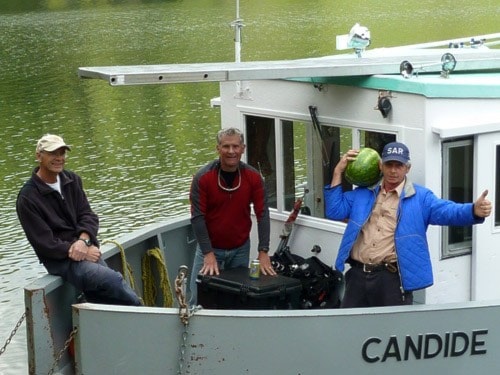An expedition this month to the SS City of Ainsworth found the historic Kootenay Lake shipwreck remains in generally good condition.
“We were all very excited to see that the vessel hasn’t deteriorated as much as we might have thought,” says Bill Meekel of the Underwater Archaeological Society of BC, who led the search.
“At least the hull and main structure of the [lower] deck and paddlewheel were all still pretty much intact. It’s still three dimensional.”
Meekel’s party included society members Eric and Bronwen Young, plus Darren Muntak, and Brian Nadwidny. Working from the Kaslo Shipyards vessel Candide, they used sidescan sonar and a remotely-operated vehicle to locate and inspect the ship, which has only been seen a handful of times since it sank in 1898, taking nine lives.
Meekel also led an expedition last fall, which inspected the Ainsworth’s debris field.
He says their first challenge this time was finding the ship, which rests 117 metres underwater off Crawford Bay. Although they had global positioning coordinates from a 1990 survey of the wreck, they no longer apply under today’s system.
“We didn’t really have even a starting point last year when we were looking,” he says. “We went back to the original data, based on some simple angles and triangulation off a couple landmarks. We used that and satellite images to come up with new lattitude and longitude for where the wreck should have been.”
Although they had some problems with shifting winds, the sonar confirmed something was down there. But they had to wait a day for better weather before they could drop the video camera-equipped robot and verify it as the Ainsworth.
“We got an assessment of at least the back quarter of the vessel,” Meekel says. “A maple leaf cut into the cover for the paddlewheel is still there, and an interesting series of intersecting arcs are still in place.”
The video also showed the main drive arm from the ship’s steam cylinder on the starboard side to the paddlewheel axle, plus scrollwork and detailed carpentry.
“So it’s a pretty picture,” Meekel says. “It’s a really good look at the joinery work done at that time. It also shows the hull area where there’s still paint.”
A problem with the robot prevented them from completing the assessment, but Meekel says they would like to return.
“What we’ve seen so far is it certainly hasn’t gone two dimensional where everything just kind of collapses,” he says. “We don’t have issues with wood boring organisms in fresh water. The wreck is in a low current, and deep, cold environment, so it’s probably the best location to preserve it long term.”
Launched in 1892, the City of Ainsworth was plagued with problems before it was finally lost in a storm, killing six crew and three passengers. Their bodies were never found.
When the wreck was first located in 1990, the pilot house was missing and the upper deck shattered. It’s now a protected site under the provincial Heritage Conservation Act. In 1997, Bart Bjorkman and John Chluski became the first divers to successfully reach it.
“We really benefitted from the work done previously,” Meekel says. “We did not find [the Ainsworth] for the first time. We’re just finding it again. It’s kind of like an update.”
To cap their expedition, Meekel’s group dived on a set of sunken rail cars at Procter
